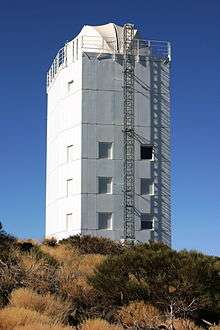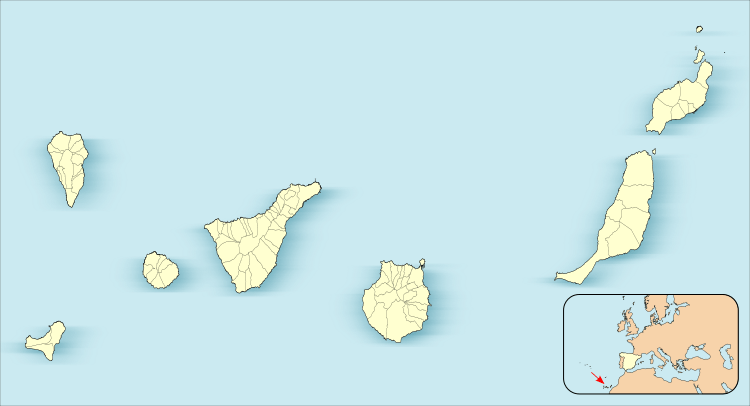GREGOR Solar Telescope
GREGOR is a solar telescope, equipped with a 1.5 m primary mirror.[1] located at the Teide Observatory on Tenerife in the Canary Islands. It replaces the older Gregory Coudé Telescope and was inaugurated on May 21, 2012.[2][3] First light was on March 12, 2009.[4][5]
 | |
| Part of | Teide Observatory |
|---|---|
| Location(s) | Tenerife, Atlantic Ocean |
| Coordinates | 28°18′06″N 16°30′39″W |
| Organization | Kiepenheuer Institute for Solar Physics Leibniz Institute for Astrophysics Potsdam Max Planck Institute for Solar System Research |
| Wavelength | 350 nm (860 THz)-2.0 μm (150 THz) |
| First light | 12 March 2009 |
| Telescope style | Gregorian telescope optical telescope solar telescope |
| Diameter | 1.5 m (4 ft 11 in) |
| Angular resolution | 0.08 arcsecond |
| Focal length | 55.6 m (182 ft 5 in) |
| Mounting | altazimuth mount |
| Enclosure | dome |
| Website | gregor |
 Location of GREGOR Solar Telescope | |
GREGOR is the third-largest solar telescope in the world, after the Big Bear Observatory and the McMath-Pierce solar telescope. It is aimed at observing the solar photosphere and chromosphere at visible and infrared wavelengths. GREGOR sports a high-order adaptive optics (AO) system with a 256-actuator deformable mirrors and a 156-subaperture Shack-Hartmann wavefront sensor. Efforts are underway to implement multi-conjugate AO in 2014.[6]
See also
References
- "Präziser Blick in die Sonne dank temperaturstabiler Glaskeramik". 2012-05-30. Retrieved 2016-04-14.
- "GREGOR Telescope". KIS website. Kiepenheuer-Institut für Sonnenphysik. Retrieved 11 January 2014.
- "GREGOR". IAC website. Instituto de Astrofísica de Canarias. Retrieved 11 January 2014.
- First light was obtained with a 1-meter test-mirror due to manufacturing issues with the main mirror
- "GREGOR telescope: Zooming in on the sun". phys.org website. phys.org. May 10, 2012. Retrieved 11 January 2014.
- "GREGOR Optical Design". KIS website. Kiepenheuer-Institut für Sonnenphysik. Retrieved 11 January 2014.
Sources
- "GREGOR - A New Telescope for Solar Physics". AIP website. Leibniz Institute for Astrophysics Potsdam. Retrieved 11 January 2014.
This article is issued from Wikipedia. The text is licensed under Creative Commons - Attribution - Sharealike. Additional terms may apply for the media files.